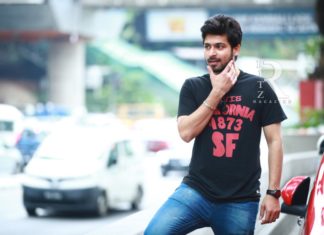It’s been a long and arduous journey for Rajiv Chilaka, the founder of Green Gold Animation, who is better known as the creator of Chhota Bheem. He talks to Minal Khona about his creation, future plans and why the brave nine-year-old will always be special
Entering the Green Gold office leaves you in no doubt about where you are. A 3-feet tall Bheem stands at the door, grinning, and the lobby is full of his pals from the very popular series, “Chhota Bheem”. Comics with the lovable character and posters of other creations adorn the walls and the place bears no resemblance whatsoever to Dholakpur, the fictional village where Bheem lives. “Children are usually very disappointed when they come here,” Rajiv laughs when I ask him about it. “They expect to see Dholakpur when you tell them this is where Bheem is created.”
The story of Rajiv Chilaka, a software engineer-turned-animator, is unusual to say the least. Time spent in a library in the US got him reading up on Walt Disney, which stoked a long-standing passion for cartoons and animation. He saved up some money, did a course in animation and returned to India with one single aim: To set up an animation company in India on par with the ones in the West. He says, “I wanted to give Indian kids content that was truly Indian. I believe that with any industry, if there is no local consumption within the country it is made in, the industry will perish. In the year 2001, India was at a critical juncture and I believed I had the qualities to lead a company that produces quality animated content.”
After ten long years which included several setbacks like the office building catching fire; lukewarm reactions to Rajiv’s first creation Bongo, an alien; serials like Krishna and Balaram, and Vikram Betaal which received good ratings but failed to take off; it was Chhota Bheem to the rescue. Rajiv recalls, “Our products were good but somewhere our business model didn’t work. Our costs had to be spread out over a larger amount of content. That happened with Chhota Bheem and it was a hit from the start.”
The USP of Chhota Bheem is that he is completely Indian. The laddoo loving boy is brave, plays fair and is in Rajiv’s words, “an ideal child”. “Every little boy wanted to be like Chhota Bheem. I was very clear that my characters were not going to ape the West or try to impress Westerners. The market needed content like ours and the timing was right. Parents loved it and children adored him.”
While the series has gained popularity across countries like Sri Lanka, Malaysia and Indonesia and there are enquiries coming in from North America as well, the original creations have been retained. The only tweaking done, says Rajiv, was reducing the violence, which was making children aggressive, according to parents’ complaints. “Even then, in ten minutes of programming we had about three minutes of fighting scenes but we toned them down,” says Rajiv. He adds, “Just like Bollywood films used to have the hero as an ideal man, children aspire to be Bheem. They don’t understand shades of grey in a character; it has to be black or white.”
Does that mean all the characters are good guys in Chhota Bheem’s coterie? Rajiv replies, “No, but I made it a point to create characters that children can relate to. Every class will have one bully and Kalia is that bully on the serial. He is not a bad guy, he is just jealous of Chhota Bheem. His followers, Dholu and Bholu don’t openly say they like Chhota Bheem but they do. That usually happens with kids at school where some get bullied into doing what one guy does even if they don’t always want to.”
Given that the characters are so easily relatable, where did Rajiv look for inspiration? Did he go down memory lane and delve into his own childhood? He says, “Actually, yes. As a child I was like Raju but Chhota Bheem is the kind of boy I wanted to be. Also, the twins Dholu and Bholu – I had these two friends who were cousins – they were really thin and lean and would get beaten up during fights. But that never deterred them from getting into a fight, they were fearless. I created the twins based on them. Chutki has a little bit of my older sister in her and since it was animation, I wanted a pet that would be different. So I created Jaggu the talking monkey.”
So while Chhota Bheem goes about solving people’s problems, he remains quintessentially a laddoo loving, intelligent kid who likes to have fun too. What is it with the laddoos I ask. Rajiv says, “Because I wanted Chhota Bheem to be a good example for kids to follow, I gave him traits that are completely Indian. Laddoos come in various forms and most of them can be quite healthy. A mother can even make a laddoo out of dal and rice to convince a child to eat it. So I brought in this element.”
Children of course get very involved with the series and the stories therein. At an event, even Rajiv was flummoxed with the questions some of the kids asked. He recalls with a smile, “A couple of girls once asked me, ‘Who will Chhota Bheem marry – Princess Indumati or Chutki?’ I didn’t know what to say so I made up some remark about friendship being more important than love. Another set of questions I get asked a lot is ‘Where is Dholakpur? Is there an airport? How does one go there? Is it in North or South India?’ I have tried to give Chhota Bheem a pan-India appeal which is why Dholakpur could be anywhere.”
The reason for Chhota Bheem’s popularity besides the obvious one – boys and girls loving him – is that parents approve of the moral values and ideals that the series tries to inculcate through the characters. Rajiv is involved to this day with the script. “Earlier I would write it like a narrative story and my script writers would work on it. Now that other aspects of the business take up my time, I give them a basic story line and they develop it. All credit goes to them.”
The business is now making a profit after years of being in the red and needless to say, there are offers of investments and takeovers. Rajiv reiterates, “Yes, there are offers but I resist and always say no. At this point in time, I am enjoying what I do and I don’t want to give up that independence.” It is the same reason why he doesn’t want to go public just yet. “Then it becomes a rat race where you only focus on the figures and that is not something I want right now.”
Luckily for Rajiv, the merchandise segment of the business is doing very well with the toys, the comics, the tees etc. Any plans of having a Chhota Bheem theme park, I ask. He says, “Yes eventually. Getting the land is easy, it is the technological challenges that are many and difficult. I would like to develop some more characters before I think of doing it.”
The businessman in Rajiv continues to be inspired by Walt Disney. “If I achieve ten per cent of what Walt Disney achieved, I would consider myself a success. He has given a clear road map and I am following that map. But getting to the level of Pixar or Disney is still a long way off,” he admits.
Parental and sibling support, a wife who brought luck and fatherhood which has forced Rajiv to strike a work-life balance and made him more focussed. But the ambition to create a legacy and take Green Gold to the next level remains. On the anvil are plans to make a 3D movie with Chhota Bheem, create more characters and perhaps tie up with health food manufacturers for healthy drinks and snacks for children. More attention to games and apps for this tech-savvy generation are also on the agenda. Collaborations for Green Gold franchises, partnering with the right NGOs for CSR projects and expansion plans are all part of the growth plan.
But behind all the expansion and the adulation, what remains the moving force according to Rajiv is Chhota Bheem himself. He says, “Chhota Bheem is very close to my heart. To me he is real, I feel like he is my own son. And I thank him for all my success.” Tall achievement that, for a nine-year-old animated boy.







 Raashii Khanna
Raashii Khanna










